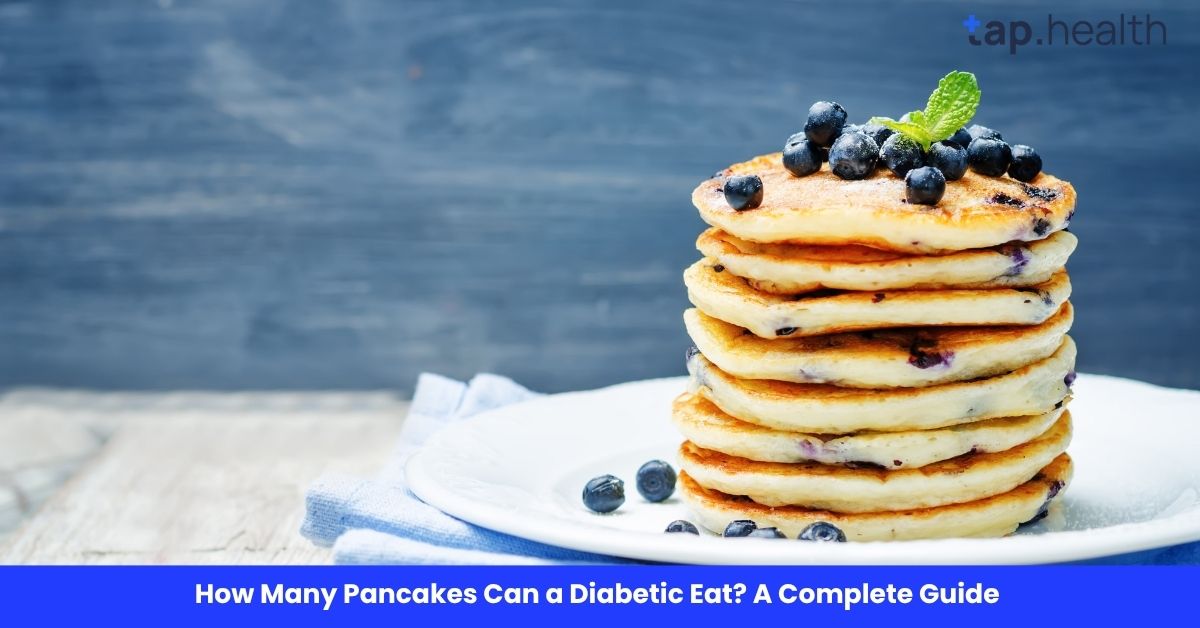For individuals living with diabetes, managing blood sugar levels is a top priority. Pancakes, a beloved breakfast food, are often loaded with carbs and sugars that can spike blood sugar levels. This leads many diabetics to wonder: How many pancakes can I eat without risking my blood sugar?
The good news is that with the right ingredients, portion control, and smart choices, it is possible for diabetics to enjoy pancakes. However, there are several factors to consider before digging into a stack of pancakes. This article provides a thorough guide to how many pancakes a diabetic can eat while managing their condition.
What Happens to Blood Sugar After Eating Pancakes?
Before delving into how many pancakes a diabetic can eat, it’s important to understand the effect pancakes can have on blood sugar.
Pancakes are primarily made from flour, which is a carbohydrate. Carbohydrates break down into glucose (sugar) in the bloodstream, leading to a rise in blood sugar levels. This is especially true when pancakes are made with refined white flour, which has a high glycemic index (GI). The higher the GI of a food, the faster it is digested and absorbed, leading to a quicker rise in blood sugar.
For diabetics, rapid blood sugar spikes can be dangerous and lead to complications over time. Therefore, managing carbohydrate intake is key to keeping blood sugar levels stable.
Key Takeaways:
- Pancakes made with refined white flour can cause blood sugar spikes.
- Carbohydrates from pancakes break down into glucose, raising blood sugar.
- Portion control and ingredient choices are important for managing blood sugar.
How Many Carbs Are in a Typical Pancake?
The number of carbs in a pancake depends on its size and the ingredients used. On average, a regular pancake (about 4 inches in diameter) made with traditional ingredients like white flour and sugar contains around 15–20 grams of carbohydrates.
However, if you enjoy a larger stack of pancakes, the carb content can quickly increase, causing a larger spike in blood sugar. This is why it’s essential for diabetics to pay attention to both the number of pancakes they consume and the ingredients used.
Example of Carbs in a Regular Pancake:
- 1 standard pancake: 15–20 grams of carbohydrates
- 2 pancakes: 30–40 grams of carbohydrates
- 3 pancakes: 45–60 grams of carbohydrates
The general recommendation for diabetics is to limit their carbohydrate intake at each meal to help maintain stable blood sugar levels. For most diabetics, this means aiming for a carb count of 30–45 grams per meal.
Key Takeaways:
- A regular pancake contains around 15–20 grams of carbs.
- A typical meal for diabetics should contain 30–45 grams of carbs.
Can Diabetics Eat Pancakes in Moderation?
The short answer is yes, diabetics can eat pancakes in moderation. However, the key to enjoying pancakes without affecting blood sugar too much lies in portion control, ingredient selection, and balancing the meal with protein, fiber, and healthy fats.
Eating too many pancakes at once can cause a blood sugar spike, so it’s important to keep the portion size small. For example, one or two pancakes (depending on the carb content) can be a good choice for a diabetic breakfast.
Tips for Eating Pancakes in Moderation:
- Control portion sizes: Stick to one or two pancakes rather than a large stack.
- Balance with protein and healthy fats: Pair your pancakes with eggs, yogurt, or nuts to balance blood sugar levels.
- Avoid extra sugar: Use sugar substitutes or fresh fruit instead of syrup or powdered sugar.
By making healthier choices and keeping portions in check, diabetics can enjoy pancakes without significantly raising their blood sugar levels.
Key Takeaways:
- Diabetics can eat pancakes in moderation.
- Portion control, healthy ingredients, and pairing with protein are key to preventing blood sugar spikes.
What Are the Best Pancake Alternatives for Diabetics?
While traditional pancakes made with white flour may not be the best choice for diabetics, there are several healthier alternatives that can help manage blood sugar while still satisfying your pancake cravings.
1. Almond Flour Pancakes
Almond flour is a great low-carb, high-protein alternative to regular flour. It has a lower glycemic index and is packed with fiber, which helps regulate blood sugar levels. Almond flour pancakes are a perfect option for diabetics looking for a filling and nutritious breakfast.
2. Coconut Flour Pancakes
Coconut flour is another low-carb alternative that is rich in fiber. It also has a low glycemic index and is gluten-free, making it suitable for people with gluten sensitivities. Coconut flour pancakes are fluffy and delicious, and they can be a great way to enjoy a diabetic-friendly breakfast.
3. Oatmeal Pancakes
Oats are a whole grain that is high in fiber and has a lower glycemic index compared to refined grains. Oatmeal pancakes made with rolled oats or oat flour can help keep blood sugar levels stable while providing a filling breakfast.
4. Flaxseed Pancakes
Flaxseeds are rich in fiber and healthy omega-3 fatty acids, making them a great addition to a diabetic-friendly pancake recipe. Flaxseed pancakes are also low in carbs and can provide a nutritious alternative to traditional pancakes.
Key Takeaways:
- Almond flour and coconut flour are great low-carb options.
- Oats and flaxseeds are high in fiber and have a low glycemic index.
What Can Diabetics Use Instead of Syrup?
Traditional syrup is high in sugar and can cause a rapid spike in blood sugar levels. However, diabetics can enjoy pancakes with alternative toppings that are healthier and won’t lead to blood sugar spikes.
1. Sugar-Free Syrup
Sugar-free syrup is a common alternative for diabetics. These syrups are made with sugar substitutes like stevia, sucralose, or erythritol, which have little to no effect on blood sugar. However, be cautious of the carb content in sugar-free syrups, as some may still contain small amounts of carbohydrates.
2. Fresh Fruit
Fresh fruit, like strawberries, blueberries, or raspberries, can provide natural sweetness without causing a blood sugar spike. Berries, in particular, are low in carbs and high in fiber, making them an excellent choice for diabetics.
3. Greek Yogurt
Greek yogurt is rich in protein and can be a great topping for pancakes. It can add a creamy texture and natural sweetness without raising blood sugar levels significantly.
4. Nut Butters
Nut butters, such as almond butter or peanut butter, are high in healthy fats and protein. They are an excellent choice for diabetics, as they help balance blood sugar levels while adding flavor and richness to pancakes.
Key Takeaways:
- Sugar-free syrup is a good option, but check for carb content.
- Fresh fruit, Greek yogurt, and nut butters are healthy, blood sugar-friendly toppings.
Can Diabetics Eat Pancakes Every Day?
While pancakes can be part of a healthy diet for diabetics, eating them every day is not ideal. Pancakes, even healthy alternatives, still contain carbohydrates that can affect blood sugar levels. It’s important to eat a balanced diet that includes a variety of foods, with pancakes being enjoyed in moderation.
Tips for Daily Breakfast:
- Rotate your breakfast: Have pancakes once in a while, but mix up your breakfast choices to include other healthy options like smoothies, eggs, or oatmeal.
- Balance the meal: Always include protein and fiber to prevent blood sugar spikes.
- Watch portion sizes: Stick to one or two pancakes, and avoid excessive toppings or sugary syrups.
Key Takeaways:
- Eating pancakes every day is not recommended for diabetics.
- Enjoy pancakes in moderation and rotate other breakfast options.
Real-Life Scenario
Imagine a diabetic attending a weekend brunch. The menu includes fluffy pancakes with syrup and butter. Eating 3 large pancakes with syrup could dramatically raise blood sugar levels. Instead, choosing 1–2 smaller pancakes, adding fresh fruit, and skipping sugary toppings helps enjoy the meal without causing a spike.
Expert Contribution
Endocrinologists and dietitians recommend balancing carbohydrates with protein and fiber. Dr. Ritu Sharma, a diabetes specialist, notes that “a single serving of pancakes with protein-rich sides can fit into a diabetic meal plan, but moderation is key.” Choosing low-GI (glycemic index) ingredients, like oats or whole wheat, can also help maintain steady blood sugar levels.
Recommendations Grounded in Proven Research and Facts
- Portion control: Stick to 1–2 small pancakes per meal.
- Choose healthier flours: Whole wheat, oat, or almond flour reduce blood sugar spikes.
- Add protein and fiber: Eggs, Greek yogurt, or chia seeds can slow sugar absorption.
- Limit sugary toppings: Use fresh fruit, cinnamon, or sugar-free syrup instead of butter and maple syrup.
- Monitor blood sugar: Check post-meal levels to understand how pancakes affect you personally.
FAQ: How Many Pancakes Can a Diabetic Eat?
1. How many carbs can a diabetic eat at breakfast?
Most diabetics should aim to consume 30–45 grams of carbohydrates per meal. This will vary depending on individual needs and blood sugar goals.
2. What’s the best flour for diabetic pancakes?
Almond flour and coconut flour are the best options for diabetics, as they are low in carbs and have a low glycemic index.
3. Can diabetics eat pancakes with syrup?
Diabetics can eat pancakes with sugar-free syrup or other alternatives like fresh fruit, Greek yogurt, or nut butter.
4. Can I make pancakes for a diabetic-friendly breakfast?
Yes, using low-carb flours, limiting portion sizes, and choosing healthy toppings can make pancakes a safe breakfast for diabetics.
5. How often can diabetics eat pancakes?
Diabetics should enjoy pancakes in moderation and not every day. It’s best to balance your meals with a variety of other healthy options.
Conclusion
Diabetics can enjoy pancakes, but it’s important to manage portion sizes, choose healthy ingredients, and pair them with protein and fiber to avoid blood sugar spikes. By using alternatives like almond flour, coconut flour, and fresh fruit, diabetics can create a breakfast that is both satisfying and blood sugar-friendly. With proper planning and moderation, pancakes can be a part of a balanced diabetic diet.



